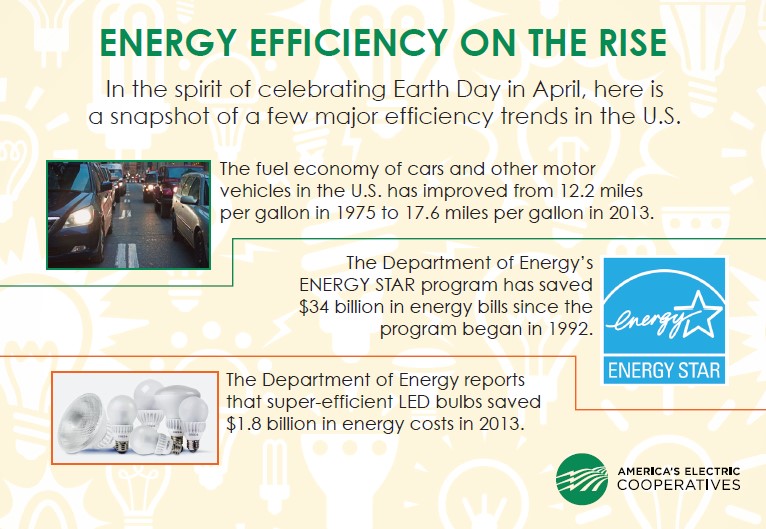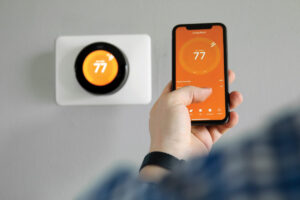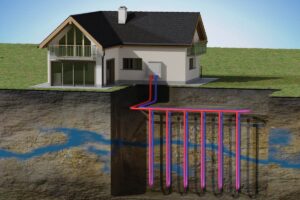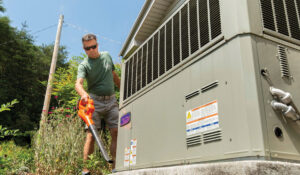 April 22 will mark the 45th celebration of Earth Day. The rallies and marches in the spring of 1970 called for more attention to protecting the environment. If you measure the success of that cause by greater energy efficiency, the results have been remarkable and the future holds great promise.
April 22 will mark the 45th celebration of Earth Day. The rallies and marches in the spring of 1970 called for more attention to protecting the environment. If you measure the success of that cause by greater energy efficiency, the results have been remarkable and the future holds great promise.
Here are a few examples of increases in energy efficiency during the past decades:
- The fuel economy of cars and other motor vehicles in the U.S. has improved from 12.2 miles per gallon in 1975 to 17.6 in 2013. You might think this would mean cars have lost some of their “giddyup,” but horsepower steadily increased during that time, and 0-60 mph acceleration went from 14 seconds to 8 seconds.
- New light bulb technologies shine when it comes to using less energy. The Department of Energy says that from 2001 to 2010, lumens per watt rose from 45 to 58. That resulted in a 9 percent drop in the amount of electricity used for lighting during a decade when the number of bulbs increased 18 percent.
- The Department of Energy’s Energy Star program of efficiency ratings for everything from appliances to buildings says people bought 5.2 billion ENERGY STAR-rated products, saving $34 billion in energy bills since the program began in 1992.
Here’s what experts predict for the future.
- The Department of Energy reports that super-efficient light-emitting diode (LED) bulbs saved $1.8 billion in energy costs in 2013, and that $39 billion would be saved if all bulbs switched to LEDs.
- A report from the American Council for an Energy-Efficient Economy says “There are large and cost-effective energy efficiency opportunities that, by 2050, can collectively reduce energy use by 40 to 60 percent relative to current forecasts.”
“The best is yet to come,” says Brian Sloboda, an energy expert with the National Rural Electric Cooperative Association. Sloboda sees “amazing new technologies” that will continue the progress in energy efficiency.
He cites lighting as an example of how far we’ve come and how far we can still go. Light bulb efficiency has skyrocketed in the last 20 years, from incandescent lights, to compact fluorescent lights (the curly CFL bulbs), to LEDs. A promising new technology, OLEDs—organic light emitting diodes, isn’t even a bulb, but lighting made of flexible material that can be applied to a variety of surfaces.
“Instead of having ceiling lights, the ceiling would actually be made of OLED material. During the day it looks like a regular ceiling, but at night the ceiling itself would glow,” says Sloboda. “Instead of having light poles or roadway lighting, you could actually make the OLED material into the roadway so the stripes on the road provide the lighting. It could completely change the way architects design our buildings.”
The American Council for an Energy-Efficient Economy (ACEE) lists a variety of steps for a more efficient future. Those include better energy habits in our own lives, more efficient electronic equipment and smart systems (like thermostats) that adjust to your daily schedule.
“If we aggressively pursue these efficiency opportunities,” says the ACEEE, “we can roughly double the rate of efficiency improvement in the next 35 years relative to the past 35 and reduce energy use to half the current forecasts.”
Paul Wesslund writes on cooperative issues for the National Rural Electric Cooperative Association, the Arlington, Va.-based service arm of the nation’s 900-plus consumer-owned, not-for-profit electric cooperatives.







